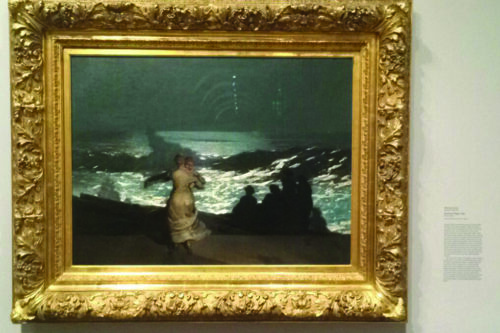New Winslow Homer at the Fogg.
By CAROLINE CRONIN
Winslow Homer (1836 – 1910) is remembered as one of America’s favorite painters. Homer first cut his teeth on sketchings of the Civil War, which were often published in the widely read magazine Harper’s Weekly. He soon grew to become one of this country’s most notable artists, and is credited with finding and establishing a feeling that is characteristically American in his work. It is most evident in his paintings of natural scenes including, but certainly not limited to, his extensive work on the Adirondack Mountain region.
Cantabrigians today sing new praises of Homer as his seminal nocturne Summer Night is now on display at the Fogg of Harvard Art Museums. The painting is located on the second floor of the museum in the Suzanne and Terrence Murray Gallery. Its deep and dark hues are visible from the outer hall as museum visitors walk slowly and appreciatively in and out of the many different rooms. Summer Night depicts two women dancing on a beach in the evening. The waves roll in the background and silhouettes of friends sit on the right side.

The lovely view of summer during a Boston winter is rare. Thus, the Harvard Art Museums is doing everything it can to celebrate the painting now. On Monday of this week, museum curators had to cancel a midday talk about the painting due to illness, but they have posted a video on the museum website discussing their work with the painting; where it is placed and how they want museum visitors to experience it. On Wednesday evening, as well, the museum held an M. Victor Leventritt Fund lecture on Homer’s painting. The lecture featured Frank Goodyear, co-director of the Bowdoin College Museum of Art; Helene Valance, assistant professor of English at Université de Franche-Comté; and Jennifer Roberts, who is the Elizabeth Cary Agassiz Professor of Humanities at Harvard. All three of the noteworthy speakers have done substantial work with Homer and the subjects he pursued.
The Summer Night piece measures 76.5 × 102 cm, and with its thick golden frame and striking movement, cannot but help draw viewers close. But as security guards look on warily, viewers continue to move past the walls dotted with other famous American artists of the nineteenth to twentieth centuries; such as Thomas Eakins (1844-1916), James Abbott McNeill Whistler (1834-1903) and John Singer Sargent (1856-1925). Situated amongst these and other works of Homer like the Brush Harrow – which is a rather sensitive Civil War piece painted in 1865 – the nocturne is quite at home.
However, Summer Night is currently only on loan from the Musée d’Orsay of Paris. The painting was created in 1890 and, after being unable to find a buyer in New York, Homer sent it to Paris in 1900, where he had traveled to (like many American painters) early in his career. Summer Night then received a gold medal at the Exposition Universelle. Since then the painting went on multiple international tours but stayed, for a significant portion of the twentieth century, in museums in Paris. The Musée d’Orsay has enjoyed the painting and describes Homer’s “lyricism tinged with mysticism” as one of the defining features of the, “feeling for nature that is peculiarly American.”
That specific point is perhaps not as obvious to American viewers of Summer Night here in Cambridge, but the painting does not fail to evoke an almost otherworldly emotion. Fogg visitor Jill Regan made the snowy trek to the museum this week specifically to see the piece. “I really like [Homer’s] Civil War work but this one has always been meaningful to me because I feel like I can hear the music and the waves,” she mused while standing a few feet from the painting. Undoubtedly, hundred of viewers across the decades have heard those same waves.
Caroline Cronin (ccronin01@college.harvard.edu) thanks her freshmen seminar professor Theodore Stebbins, the Consultative Curator of American Art at the Fogg, for her appreciation of Winslow Homer!

